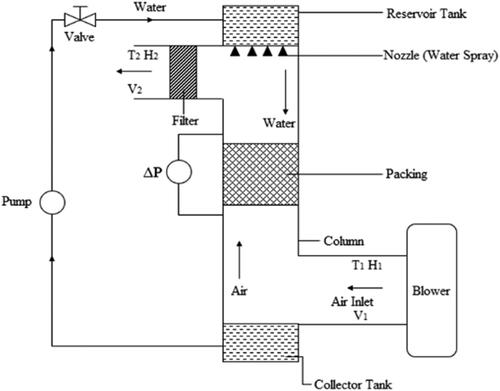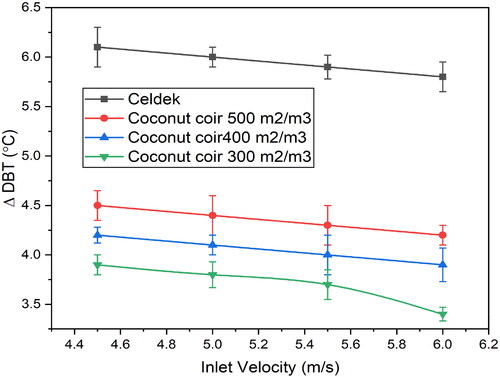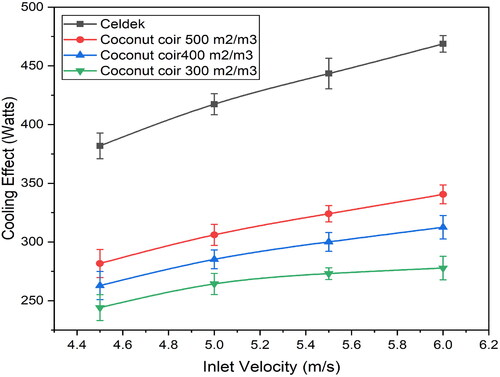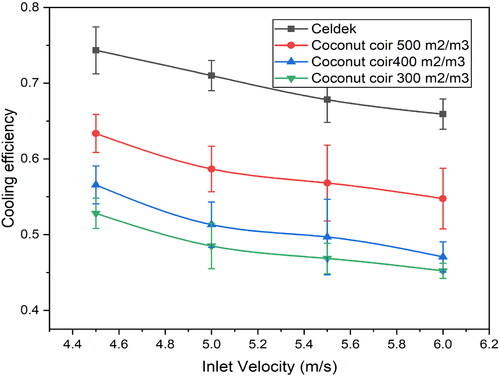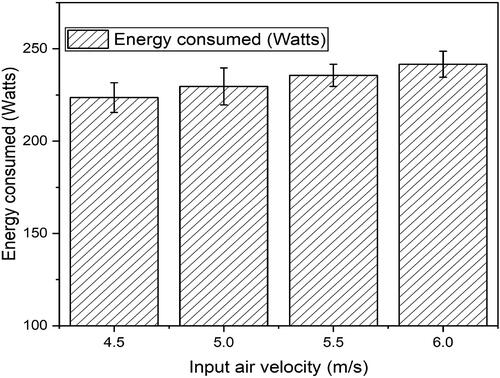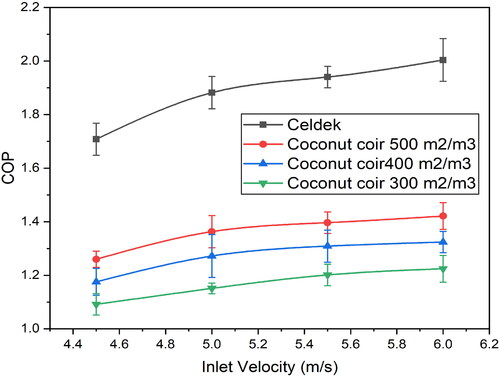 ?Mathematical formulae have been encoded as MathML and are displayed in this HTML version using MathJax in order to improve their display. Uncheck the box to turn MathJax off. This feature requires Javascript. Click on a formula to zoom.
?Mathematical formulae have been encoded as MathML and are displayed in this HTML version using MathJax in order to improve their display. Uncheck the box to turn MathJax off. This feature requires Javascript. Click on a formula to zoom.Abstract
This research is centered around the development and construction of a test apparatus for a counterflow evaporative cooler. The packing material utilized in the testing is coconut coir with wettability values of 300, 400 and 500 m2/m3. The experiments involve varying the air velocity. The study examined performance characteristics, including evaporation rates, cooler efficiency, coefficient of performance (COP) and energy consumption information, in relation to the standard Celdek 7090 packaging. The findings demonstrated that employing a coconut coir with optimal wettability resulted in a cooling efficiency and COP of 53.57% and 1.25, respectively. These values were slightly lower than those achieved with the usual Celdek 7090 packing. Coconut coir, as a biomass-derived material, possesses certain benefits that make it a suitable alternative for filling materials in evaporative cooling processes.
1. Introduction
Currently, the majority of buildings employ vapour-compression refrigeration (VCR) based systems for cooling purposes. It accounts for 32% of global energy consumption, which is a significant amount of energy and has a considerable impact on the environment. The air conditioning system is a significant consumer of energy, accounting for 20% of total energy usage (Jain & Hindoliya, Citation2011). Thus, there is a need for an alternate device that consumes minimal energy while yet providing thermal comfort within the room. Evaporative cooling is primarily favored in areas with low levels of relative humidity. Its primary function is to facilitate evaporation by extracting heat from the surrounding air (Malli et al., Citation2011). The energy consumption of a conventional evaporative cooling unit is 75% lower than that of a typical traditional AC system. It can be implemented in impoverished countries that experience a shortage of electricity. This technology possesses advantages such as a reduced initial and operational cost, as well as being more energy efficient when compared to the traditional VCR cycle (Dhamneya et al., Citation2018). Evaporative cooling can be classified into two types: direct and indirect. In the direct kind, the fluids involved in the process contact directly at the location where heat and mass transfer occur. In the indirect form, heat transfer is the only process occurring (Rawangkul et al., Citation2008).
The evaporative cooling performance is influenced by several aspects, including the material and arrangement of the packing, pad thickness, wettability, surrounding circumstances, air and water flow velocity and direction of flow (Al-Sulaiman, Citation2002). The water absorption or water retention capacity of a cooler is determined by the specific substance utilized. Multiple types of evaporative pads, including wood, glass, plastic, metal and hard paper, are utilized (Oueslati et al., Citation2015). Regular utilization of these pads exacerbates the performance. The commercially available packing materials, Celdek and Aspen, consistently shown excellent performance. Celdek pads have several advantages, including durability, lightweight design, compactness, good wettability and being free from pollution (Doğramacı et al., Citation2019). There is plenty of scope to study the hydrodynamics and thermal performance of a new type of organic packing, which is inexpensive, available freely and can be molded to the desired shape. Evaluation of the energy consumption and its comparison with the standard AC system is also paramount. Nada et al. (Citation2019) conducted a study on cellulose pads where pad thickness was varied in the wind tunnel type evaporative cooling system. Air velocity and the inlet temperature was varied. Results indicated that for highest thickness of the pad, temperature drop, pressure drop and cooling capacity was found to be 18 °C, 46 Pa and 6.26 kW. Energy efficient ratio of 281 was obtained. Salins, Reddy, Kumar, et al., 2021; Salins, Reddy, Kumar (Citation2021) considered packings made of wood chips and coir from coconut plants as the materials and related its performance with the standard cellulose packing. Experiments were directed for both counter and crossflow modes for different air mass flow rates. Results designated that wood shaving packing gave closer results to the Celdek packing. Maximum COP of Celdek, Wood shaving and Coconut coir are found to be 3.17, 2.08 and 1.41. Salins, Reddy, Kumar, et al. (2021) and Salins, Reddy, Kumar (Citation2021) constructed a counterflow humidifier that used Charcoal as the packing material. Air and water flow rates were varied along with the density of the charcoal packing. Results showed that Charcoal packing gave humidification efficiency and COP equal to 57.40% and 1.41. 400 kg/m3 of charcoal density has showed higher results. The system consumed 350 Watts of energy and it was found that the current system saved 30% of the energy compared to conventional AC systems. Sansaniwal et al. (Citation2020) reviewed the possibilities of alternative techniques for cooling. Energy savings by the evaporative cooling during summer and winter seasons were found to be 33% and 26%, respectively. Dayioğlu and Silleli (Citation2014) conducted an experimental study on the green house unit by varying the inlet air and water flow rate. Results indicated that the inside portion of green house gave a drop of 7.5 °C, cooling efficiency of 76.8% and energy savings of 22% when compared with the standard VCR unit. Aljubury and Ridha (Citation2017) studied the 2-stage evaporating cooler unit with direct and indirect type. The integrated evaporative unit gave higher performance compared to direct evaporative cooling and gave a temperature drop and energy savings of 21 °C and 35%, respectively. Warke and Deshmukh (Citation2017) considered three different packing thickness that is 50, 100 and 150 mm in a varying air velocity crossflow unit. Pressure drop across the pad, evaporation rate and energy saving percentage was found to be 90 Pa, 0.18 g/s and 28%, respectively for the highest packing thickness of 150 mm. Shahali et al. (Citation2016) used poly vinyl chloride, generally called as PVC packing with 7, 9 and 18 ribs and studied its influence on evaporative cooling with the variation of air and water flow rate, inlet water temperature and packing arrangement. Results indicated that 3 rib configuration gave higher results with a maximum efficiency, temperature drop and energy saving of 78%, 18 °C and 25%. Laknizi et al. (Citation2019) performed parametric study to fix the optimum conditions for the poultry house. The influence of cellulose pad thickness and frontal air velocity was studied. They concluded that the rate of water consumption and cooling capacity increased with increasing the thickness. The performance of celdek pad 5090 and 7090 was experimentally conducted by Malli et al. (Citation2011) in an evaporative cooler by varying the air velocities. They noticed that the amount of water evaporated, and overall pressure drop increased by increasing the air velocity and pad thickness for both kinds of pads. Effectiveness and humidity variation decreased by increasing the air velocity.
Following an extensive review of the literature, it was observed that most studies utilized counter and cross flow units, with the counter flow unit being deemed more efficient. The system utilized packing materials such as cellulose, wood shavings, charcoal, PVC, to measure the system’s performance characteristics and energy savings in comparison to the typical VCR system. Celdek packing is an effective material for evaporative coolers, but it can be expensive and is not readily available in rural areas. This means that people living in rural areas may not be able to afford to use celdek packing in their evaporative coolers. Therefore, it is important to find a cheaper alternative, such as biomass-based packing materials, to compensate for the high cost of celdek packing. Coconut coir is one such alternative that is readily available in rural tropical areas. Coconut coir is a waste product obtained from the coconut fruit and is available at no cost. It has similar characteristics to celdek packing, such as high wettability and better water holding capacity, making it a good alternative. However, there is limited research on the use of coconut coir as a packing material for evaporative coolers. Therefore, this study aims to explore the use of coconut coir as an alternative packing material in evaporative cooling units. The operational configuration was constructed, and experiments were carried out to determine various performance characteristics by examining the changes in airflow rate and pad wettability.
2. Parametric expressions
The current system consists of fluids operating in counter flow direction where the heat and mass transfer take place. The temperature of the air drops and the moisture content in the increases by evaporation process. Evaporation process occurs by converting the sensible to latent heat. It is specified by the function of specific or absolute humidity change and air flow rate.
(1)
(1)
Humidification or cooling efficiency gives the efficiency of the unit to effectively perform the heat and mass transfer It is depicted as
(2)
(2)
Energy efficiency of the present arrangement is represented by the value of COP. Coefficient of performance (COP) is defined as the ratio of the cooling effect to the sum of the energy taken by the blower and the pump. Cooling effect is given by the product of air flow rate, specific heat and change in the DBT.
(3)
(3)
3. Experimental test rig and instrumentation
3.1. Construction
shows the sketch of the counterflow humidifier unit. It consists of a reservoir and a collecting tank in which the water is sprayed using spray heads and collected. 0.3 HP blower is used to supply the air through the humidifier column whereas 0.1 HP pump elevates the water from the collector tank to the reservoir tank. Valve regulates the water flow rate whereas air filter removes the contaminants entering the room. A wire mesh box with dimensions 0.1 m × 0.1 m × 0.1 m is used for placing the celdek and coconut coir fibers. Initially, celdek 7090 with a specific area of 432 m2/m3 was used as a packing material and later replaced by coconut coir material. Wettability or specific area refers to the ratio of the total water flow surface area interacting with air to the specified volume of the packing expressed in m2/m3. In this work, the volume of the enclosure is kept constant. Therefore, as the density of the packing material is changed, wettability also changes. To attain wettability of 300, 400 and 400 m2/m3, the number of coir pieces or coir mass is varied.
3.2. Working
Air is circulated with the air velocity ranging from 4.5 to 6 m/s and the water is sprayed at a steady pace of 0.5 LPM. Both the fluids come in contact with the packing and undergo both heat and mass transfer. Sensible heat gets converted to latent heat and the air which exits carries the moisture outside the room. Temperature and humidity values are noted at various points to determine the properties of air using psychrometric charts. These values are substituted in EquationEquations (1)–(3) to obtain the performance parameters. The experiments are repeated by varying the wettability of the proposed filling material from 300 to 500 m2/m3 and compared the results with the standard Celdek packing. shows the packing frame to place the coconut coir fibers, 2(b) and 2(c) shows the coconut coir fibers and standard Celdek 7090 packing.
3.3. Measuring instruments
An anemometer measures the air velocity which has a speed range of 0–50 m/s, threshold sensitivity of 1 m/s and the resolution of 0.05 m/s. It has an accuracy of ±0.3 m/s. Hygrometer lists the relative humidity at the entry and exit position of air in the duct. It has an RH Range of 0–99%, display resolution of 0.1% and accuracy of ±2.0%. DBT is listed using a digital type of thermometer having range of −20 °C to 100 °C, with a resolution of 0.1 °C and an accuracy of ±0.1 °C. Wet bulb temperature is measured by covering the dry bulb with a cloth and dipping it in the water in such a way that the surface of the cloth just touches the water. This measures the temperature at saturation point. The total energy taken is calculated by the Energy meter for the duration of the test. It has the specifications voltage: 220V/50 Hz, current: 5–80 A, power: 17,000 W.
4. Results and discussions
Experiments are conducted with commercially available celdek packing for different values of airflow rates. At the inlet of the packing, air velocity and RH condition were maintained constant by a humidifier. Air temperatures at the inlet and at the exit, RH values at the beginning and at the departure of the duct have been monitored by sensors. Energy consumption by the motor and the pump is noted by the energy meter. Performance parameters such as cooling effect, cooling efficiency, energy consumed and COP values are found out by using EquationEquations (1)–(3) as depicted in Section 2. These values are referred to as the baseline values. The packing is replaced by coconut coir and the experiments are repeated for similar conditions as discussed earlier. Wettability values of the coconut coir are changed by changing the number of coir or density of the mixture and the same set of experiments are repeated. Results obtained from the experiments are discussed below.
4.1. Dry bulb temperature difference
In an evaporative cooler, water sprayed onto the packing gets evaporated by absorbing the sensible heat from air and hence the water temperature drips. Variation of ΔDBT with the air velocity is represented in . It is seen that as the air mass flow rate increases, ΔDBT declines for all tested conditions. When the air velocity is higher, the residence time of air drops which reduces the interaction between water and the air. Hence specific humidity change reduces followed by the small drop in the temperature. As compared with the different materials, it is realized that celdek packing shows slightly higher ΔDBT than the coconut coir. When the wettability of the coconut coir is higher, more coir mass interacts with air and water which increases the water evaporation and hence temperature substantially drops as clearly visible in . Hence it is preferred to have higher wettability values for efficient cooling using coconut coir packing.
Even though ΔDBT values are lesser than celdek packing, due to the advantages such as lower cost, reduced maintenance, availability in plenty and hence cheaper. Coconut coir-based coolers are preferred over conventional cooling techniques due to their minimal negative effects on the environment as they are biomass-based products.
4.2. Cooling effect
Cooling effect for air is calculated by the product of air mass flow rate of air and the change in the DBT value. It is understood that as the air Reynold’s number increases, cooling effect also increases which is due to the upsurge in the mass of air flowing through the duct. Even though ΔDBT values drop at higher air flow rates, an increase in the mass flow rate increases the cooling effect. Eventually, this enhancement reduces, as the air velocity is further augmented, showing an optimum air velocity is required to have a tradeoff between cooling effect and energy consumption. Again, it is observed that celdek packing performed better than coconut coir for all tested conditions as seen from . Water retention property of coconut coir is inferior to the celdek packing which can result in a lower cooling effect for a definite mass flow rate of air. Further lower wettability values exhibit lower cooling effect compared to the higher wettability indicating the improvement in performance with higher density. From the current results, it is seen that when the wettability increases from 300 to 500 m2/m3, the cooling effect increases by 26% for the maximum air flow rate.
4.3. Cooling efficiency
Effectiveness or efficiency of cooling is represented by the term called cooling efficiency which gives a measure of the cooling achieved to the maximum possible cooling that can be achieved. Analytically it is calculated as the modification in DBT values to the alteration between DBT and WBT values. It is observed that for all materials studied, it declines as the air velocity is augmented as represented in . At lower air flow rates, the temperature drop will be huge resulting in higher efficiency. ΔDBT drops as the air velocity is increased as seen from which results in decreased efficiency. Efficiency values for coconut coir is marginally lower than the celdek packing. Out of the different variations of coconut coir, higher wettability values show the higher efficiency. As the wettability values increase, more bands of coconut coir will be in connection with the water thus enhancing the water evaporation. When the quantity of water evaporated increases, sensible heat acquired by the air also increases. This causes a huge drop in air DBT values.
4.4. Energy consumption
Energy is spent for the blower for blowing the air through the packing and also by the pump in spraying water to the packing. Hence total energy consumption is the summation of the above two components. Variation of the energy consumption is revealed in . It shows that as the air Re is augmented energy consumption also increases. Higher air velocity requires higher energy to pump air from entry to the exit through the duct length. Due to the higher frictional resistances, pressure drop will be higher requiring more energy to overcome these losses. When the velocity of the inlet air is increased from 4.5 to 6 m/s, energy spent increases by 8%. It has been observed that the energy data for the different packing materials has not shown any significant changes. Although the pressure drop for coconut packing is slightly higher due to its higher frictional resistance, which is evident from the slightly lower air velocities at the duct exit, the variation in energy consumption was found to be negligible.
4.5. Coefficient of performance
It is the ratio of cooling effect to the energy consumed during the cooling process. It can be seen from the previous results that as the air velocity is increased, both cooling effect, as well as energy consumption, increases. But due to higher values of cooling effect, COP values were found to be increasing with the air velocity as shown in . But gradually the slope decreases for higher airflow rates due to the amplified energy data. Hence, a proper air flow rate at the duct inlet can result in a reasonable increase in the COP. After comparing the different materials that were tested, it was found that celdek had the highest COP, followed by coconut coir which had the highest wettability. Previous discussions suggest that celdek packing provides the highest cooling, followed by coconut coir with a wettability of 500 m2/m3, resulting in a higher COP.
4.6. Comparison with literature
Performance parameters obtained from this study are compared with the similar work undertaken by using alternative biomass packings as shown in . Important parameters such as cooling efficiency and COP are compared. As the inlet conditions and operating parameters are not exactly the same as those of this study, the trend of the results have been analyzed. It is seen that cellulose-based packing performs better than the others in terms of higher cooling efficiencies. Comparing the different biomass-based packings, the performance of coconut coir is at par with that of others. This concludes that coconut coir is considered to be an alternative packing for evaporative coolers. Further the cost of celdek 7090 is around INR 450/sq feet whereas coconut coir is freely available in village areas. It also has advantages such as lower maintenance, easily replaceable, and biodegradable. Due to these reasons, coconut coir can be recommended as an alternative packing material in evaporative coolers.
Table 1. Comparison of present results with the literature values.
5. Conclusions
In this work performance of a biomass-based material for evaporating cooling has been conducted with respect to the cooler performance and energy consumption. Results are compared with normal available cellulose-based packing material as baseline data. The results obtained can be concised as follows.
Coconut coir exhibits decent performance in terms of ΔDBT and cooling efficiency and is found to be marginally less than the commercially available celdek packing.
ΔDBT, cooling efficiency and cooling effect for coconut packing with wettability 500 m2/m3 are found to be lower by 26.2%, 33.7% and 26% respectively as compared with celdek packing for the lowest flow rate of 4.5 m/s.
When the wettability of coconut coir is increased from 300 to 500 m2/m3 the corresponding values increased by 15.3%, 9.6% and 15.1%.
When the entry velocity of air is increased from 4.5 to 6 m/s, energy consumption increased by 8.1%.
COP values were found to increase with the airflow rate. For the coconut coir with highest wettability, COP increased by 16% when the air velocity augmented from 4.5 to 6 m/s. Similarly when the wettability increased from 300 to 500 m2/m3 COP increased by 14.6% for the highest air mass flow rate.
The above work concludes that biomass materials such as coconut coir can be considered to be alternative packing materials for evaporative cooling techniques with several advantages such as easy availability at a reduced price, comparable performance with colder packing, lower maintenance, etc. Also, it reduces energy consumption compared with conventional AC systems, lower environmental pollution, and is also one of the sustainable techniques for HVAC systems.
6. Limitations of this study
A substantial increase in the temperature drop also increases the exit specific humidity of air.
Arranging the coconut coir in a stable condition is difficult unlike the celdek packing
When the humidity level outside is high, the efficiency of the evaporative cooler drops significantly.
Author contributions
Conceptualization, Shivakumar, Sampath Suranjan. and Nitesh Kumar.; methodology, Girish Hariharan, Shivakumar. Ganesha A; validation, Girish Hariharan, Nitesh Kumar., Sampath Suranjan.; formal analysis, Ganesha A, Gowri Shankar M C.; investigation, Shivakumar.; resources, Ganesha A, Sampath Suranjan.; data curation, Nitesh Kumar.; writing – original draft preparation, Girish Hariharan, Shivakumar.; writing – review and editing, Nitesh Kumar.; visualization, Nitesh Kumar.; supervision, Shivakumar.; project administration, Girish Hariharan, Gowri Shankar M C and Shivakumar.; All authors have read and agreed to the published version of the manuscript.
Disclosure statement
The authors declare no conflicts of interest.
Data availability statement
The data that support the findings of this study are available on request from the corresponding author.
References
- Aljubury, I. M. A., & Ridha, H. D. (2017). Enhancement of evaporative cooling system in a greenhouse using geothermal energy. Renew Energy, 111, 321–331. https://doi.org/10.1016/j.renene.2017.03.080
- Al-Sulaiman, F. (2002). Evaluation of the performance of local fibers in evaporative cooling. Energy Conversion and Management, 43(16), 2267–2273. https://doi.org/10.1016/S0196-8904(01)00121-2
- Dayioğlu, M. A., & Silleli, H. H. (2014). Performance analysis of a greenhouse fan-pad cooling system: Gradients of horizontal temperature and relative humidity. Tarım Bilimleri Dergisi, 21(1), 132–143. https://doi.org/10.15832/tbd.25721
- Dhamneya, A. K., Rajput, S. P. S., & Singh, A. (2018). Thermodynamic performance analysis of direct evaporative cooling system for increased heat and mass transfer area. Ain Shams Engineering Journal, 9(4), 2951–2960. https://doi.org/10.1016/j.asej.2017.09.008
- Doğramacı, P. A., Riffat, S., Gan, G., & Aydın, D. (2019). Experimental study of the potential of eucalyptus fibres for evaporative cooling. Renew Energy, 131, 250–260. https://doi.org/10.1016/j.renene.2018.07.005
- Jain, J. K., & Hindoliya, D. A. (2011). Experimental performance of new evaporative cooling pad materials. Sustainable Cities and Society, 1(4), 252–256. https://doi.org/10.1016/j.scs.2011.07.005
- Laknizi, A., Mahdaoui, M., Ben Abdellah, A., Anoune, K., Bakhouya, M., & Ezbakhe, H. (2019). Performance analysis and optimal parameters of a direct evaporative pad cooling system under the climate conditions of Morocco. Case Studies in Thermal Engineering, 13, 100362. https://doi.org/10.1016/j.csite.2018.11.013
- Malli, A., Seyf, H. R., Layeghi, M., Sharifian, S., & Behravesh, H. (2011). Investigating the performance of cellulosic evaporative cooling pads. Energy Conversion and Management, 52(7), 2598–2603. https://doi.org/10.1016/j.enconman.2010.12.015
- Nada, S. A., Fouda, A., Mahmoud, M. A., & Elattar, H. F. (2019). Experimental investigation of energy and exergy performance of a direct evaporative cooler using a new pad type. Energy and Buildings, 203, 109449. https://doi.org/10.1016/j.enbuild.2019.109449
- Oueslati, A., Hannachi, A., & Elmaaoui, M. (2015). Effect of air humidification on the pumping efficiency of water in a packed column humidifier. Energy Procedia, 74, 1381–1393. https://doi.org/10.1016/j.egypro.2015.07.784
- Rawangkul, R., Khedari, J., Hirunlabh, J., & Zeghmati, B. (2008). Performance analysis of a new sustainable evaporative cooling pad made from coconut coir. International Journal of Sustainable Engineering, 1(2), 117–131. https://doi.org/10.1080/19397030802326726
- Salins, S. S., Reddy, S. V. K., Kumar, S., & Stephen, C. (2021). Experimental investigation of humidification parameters using biomass-based charcoal as an alternative packing material. Journal of King Saud University, Science, 35, 495–505. https://doi.org/10.1016/j.jksues.2021.04.005
- Salins, S., Reddy, S. V. K., & Kumar, S. (2021). Experimental investigation on use of alternative innovative materials for sustainable cooling applications. International Journal of Sustainable Engineering, 14(5), 1207–1217. https://doi.org/10.1080/19397038.2021.1924894[]
- Sansaniwal, S. K., Mathur, J., Garg, V., & Gupta, R. (2020). Review of studies on thermal comfort in Indian residential buildings. Science and Technology for the Built Environment, 26(6), 727–748. https://doi.org/10.1080/23744731.2020.1724734
- Shahali, P., Rahmati, M., Alavi, S. R., & Sedaghat, A. (2016). Experimental study on improving operating conditions of wet cooling towers using various rib numbers of packing. International Journal of Refrigeration, 65, 80–91. https://doi.org/10.1016/j.ijrefrig.2015.12.004
- Warke, D. A., & Deshmukh, S. J. (2017). Experimental analysis of cellulose cooling pads used in evaporative coolers. International Journal of Energy Science and Engineering, 3(4), 37–43.

